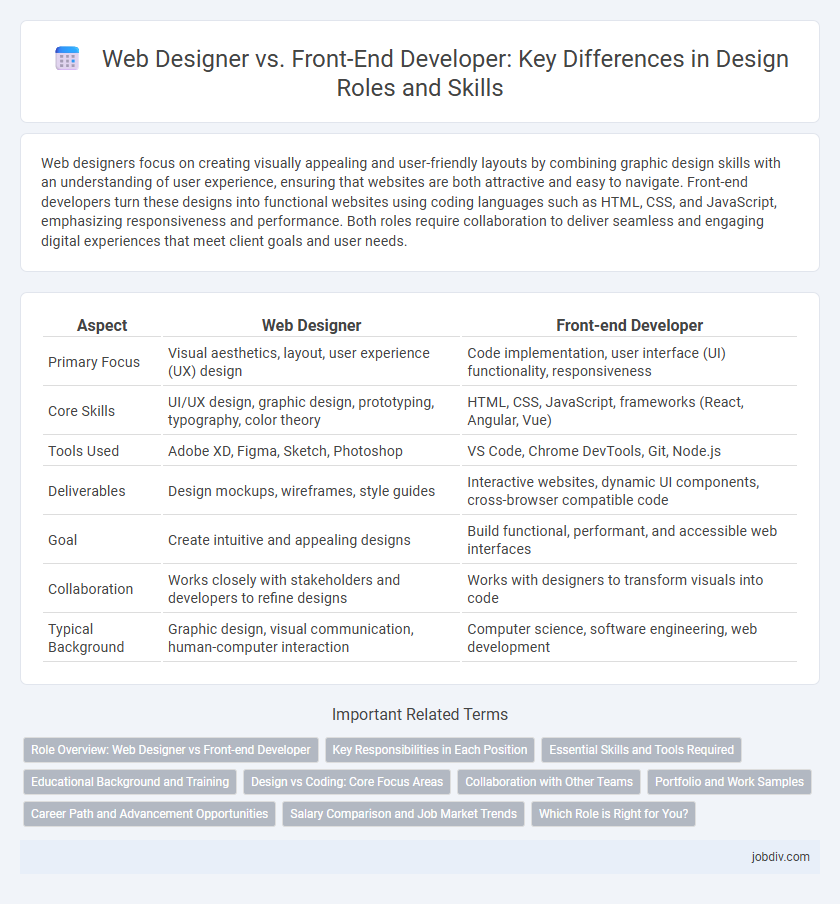Web designers focus on creating visually appealing and user-friendly layouts by combining graphic design skills with an understanding of user experience, ensuring that websites are both attractive and easy to navigate. Front-end developers turn these designs into functional websites using coding languages such as HTML, CSS, and JavaScript, emphasizing responsiveness and performance. Both roles require collaboration to deliver seamless and engaging digital experiences that meet client goals and user needs.
Table of Comparison
| Aspect | Web Designer | Front-end Developer |
|---|---|---|
| Primary Focus | Visual aesthetics, layout, user experience (UX) design | Code implementation, user interface (UI) functionality, responsiveness |
| Core Skills | UI/UX design, graphic design, prototyping, typography, color theory | HTML, CSS, JavaScript, frameworks (React, Angular, Vue) |
| Tools Used | Adobe XD, Figma, Sketch, Photoshop | VS Code, Chrome DevTools, Git, Node.js |
| Deliverables | Design mockups, wireframes, style guides | Interactive websites, dynamic UI components, cross-browser compatible code |
| Goal | Create intuitive and appealing designs | Build functional, performant, and accessible web interfaces |
| Collaboration | Works closely with stakeholders and developers to refine designs | Works with designers to transform visuals into code |
| Typical Background | Graphic design, visual communication, human-computer interaction | Computer science, software engineering, web development |
Role Overview: Web Designer vs Front-end Developer
Web designers focus on crafting the visual aesthetics, layout, and user experience of websites, utilizing tools like Adobe XD, Sketch, and Figma to create wireframes and mockups. Front-end developers transform these designs into functional interfaces using HTML, CSS, and JavaScript, ensuring responsive design and interactivity across devices and browsers. While web designers prioritize user-centric design and branding consistency, front-end developers emphasize coding efficiency, performance optimization, and integration with back-end systems.
Key Responsibilities in Each Position
Web Designers focus on creating visually appealing layouts, selecting color schemes, typography, and ensuring a user-friendly interface that enhances user experience. Front-end Developers translate these designs into functional websites using HTML, CSS, and JavaScript, optimizing site performance and implementing responsive design for various devices. Both roles require collaboration, but Web Designers emphasize aesthetics and usability, while Front-end Developers prioritize coding, interactivity, and technical integration.
Essential Skills and Tools Required
Web designers master graphic design software such as Adobe Photoshop, Illustrator, and Figma, focusing on user experience, visual aesthetics, and branding principles to create intuitive interfaces. Front-end developers require proficiency in HTML, CSS, JavaScript, and frameworks like React or Angular, emphasizing responsive design, coding standards, and cross-browser compatibility. Both roles demand knowledge of wireframing tools, version control systems like Git, and collaboration platforms to streamline the design-to-development workflow.
Educational Background and Training
Web designers typically possess a background in graphic design, visual arts, or multimedia, emphasizing aesthetics, user experience, and interface design through courses in color theory, typography, and layout. Front-end developers often have formal education in computer science, software engineering, or related fields, focusing on coding languages such as HTML, CSS, and JavaScript, along with frameworks like React or Angular. Training for web designers prioritizes tools like Adobe Creative Suite and Sketch, while front-end developers engage in bootcamps or certification programs that emphasize programming fundamentals and responsive web development techniques.
Design vs Coding: Core Focus Areas
Web designers prioritize visual aesthetics, user experience, and interface layout, focusing on color schemes, typography, and overall site consistency. Front-end developers concentrate on coding the design into functional web pages using HTML, CSS, and JavaScript, ensuring responsiveness and interactivity. The core distinction lies in design creativity versus technical implementation, merging artistic vision with programming skills.
Collaboration with Other Teams
Web Designers and Front-end Developers collaborate closely with UX designers, product managers, and back-end developers to ensure cohesive project execution and seamless user experiences. Effective communication tools like Figma and Jira streamline this cross-functional teamwork, enhancing iterative design and development cycles. Shared understanding of design principles and coding constraints facilitates efficient problem-solving and accelerates product delivery.
Portfolio and Work Samples
A web designer's portfolio highlights creativity, user interface design, and visual aesthetics with projects often showcasing wireframes, mockups, and completed websites emphasizing layout and typography. Front-end developer portfolios emphasize coding skills, interactive elements, responsive design, and technical proficiency, frequently including GitHub repositories, live demos, and detailed explanations of HTML, CSS, and JavaScript usage. Clients and employers assess web designers by design innovation and usability, while front-end developers are evaluated based on functionality, clean code, and seamless user experiences.
Career Path and Advancement Opportunities
Web designers typically focus on visual aesthetics and user experience, mastering tools like Adobe XD and Figma, which paves the way toward senior design roles or UX/UI specialization. Front-end developers concentrate on coding with HTML, CSS, and JavaScript, enabling progression into roles such as lead developer, technical architect, or full-stack developer. Both career paths offer advancement through portfolio development, skill enhancement, and adapting to emerging technologies like responsive design and interactive interfaces.
Salary Comparison and Job Market Trends
Web designers typically earn an average salary ranging from $50,000 to $75,000 annually, while front-end developers command higher wages between $70,000 and $110,000, reflecting their broader technical skill set. Job market trends reveal strong demand for front-end developers due to the increased complexity of interactive web applications, whereas web designers remain crucial for UI/UX-focused roles emphasizing visual aesthetics. The growing emphasis on responsive design and mobile-first approaches continues to shape salary growth and hiring practices within both professions.
Which Role is Right for You?
Choosing between a web designer and a front-end developer depends on your passion for visual creativity versus technical coding skills. Web designers excel in creating user-friendly layouts and aesthetics using tools like Adobe XD and Figma, while front-end developers specialize in implementing designs with HTML, CSS, and JavaScript to build functional websites. Evaluating your strengths in design principles or programming will help determine the ideal career path in the digital design ecosystem.
Web Designer vs Front-end Developer Infographic

 jobdiv.com
jobdiv.com